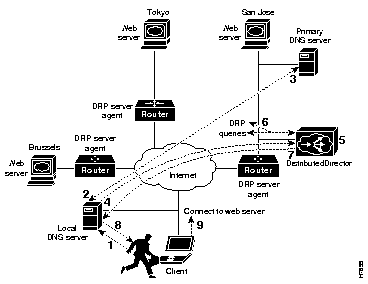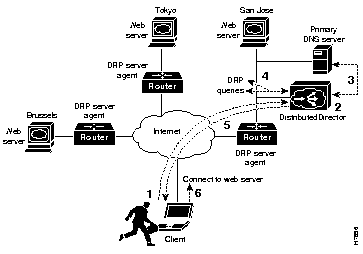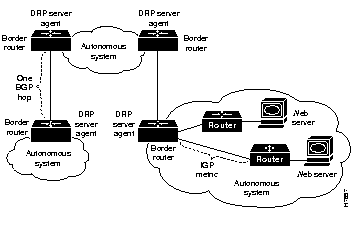|
|

This chapter provides an overview of the Cisco DistributedDirector 4700-M in the following sections:
The Cisco DistributedDirector 4700-M (called the Director throughout this guide) is a device that efficiently distributes Internet services among topologically dispersed servers on the Internet or an intranet. It provides scalable, transparent, and network-intelligent traffic load distribution.
Using the Director Response Protocol (DRP), a simple User Datagram Protocol (UDP)-based application developed by Cisco, the Director can query properly configured Cisco routers in the field for Exterior Gateway Protocol (EGP) and Internal Gateway Protocol (IGP) topological "distance" metrics. With this information and other configuration metrics, the Director can assign an optimal distributed server to each client. As a result, users can be transparently and automatically assigned a distributed server anywhere on the Internet.
In addition to the Director device, the following equipment participates in the Director system:
The Director can operate in two modes: DNS caching name server mode or HTTP session redirector mode. Distributed servers are assigned to a subdomain or host name that is serviced by the Director. The Director can support multiple subdomains and host names that are configured separately, and they can use different modes.
In DNS caching name server mode, the Director acts as the DNS caching name server for a specific subdomain. Here is how a request can be serviced (see Figure 1-1):

In HTTP session redirector mode, the Director provides HTTP session redirection services. Here is how a request can be serviced (see Figure 1-2):

You can configure the Director with one or more of the following metrics:

The metrics in the list apply per subdomain or host name. You can weight these metrics so that one is more important than another or prioritize the metrics so that if multiple servers are equally suitable another metric is applied to find the best server, or both.
The effectiveness of the DRP external metric is determined by the quality of data in the BGP routing tables. The effectiveness of the DRP internal metric is determined by the quality of data in the IGP routing tables. All DRP server agents assigned to a subdomain or host name should use the same type of IGP, such as Routing Information Protocol (RIP or RIP2), Interior Gateway Routing Protocol (IGRP), or Open Shortest Path First (OSPF).
When the server availability parameter is enabled for a distributed server, the Director uses periodic, temporary TCP connections to verify that the server is available and prevents the Director from redirecting clients to a server that cannot respond.
To increase performance, the Director caches the sorting information for each client on a per-local-DNS basis for a default period of one minute. This means that an initial request to the Director from a specific local DNS server triggers DRP querying and DRP reply sorting. The Director caches the sorted DRP replies, along with the IP address of the querying local DNS server. Subsequent Director queries issued by the same local DNS server (within the one-minute window) are fulfilled by sending this cached entry. This is efficient because the local DNS server will probably issue DNS requests for large numbers of clients, and the caching eliminates DRP querying for multiple users in the same topological proximity as their shared DNS server. Performance is improved and network overhead is decreased.
To prevent a local DNS from caching information it receives from the Director, resource records returned by the Director have a default time-to-live (TTL) value of zero seconds. However, the TTL attached to DNS replies is configurable.
To help prevent DRP-based denial-of-service attacks on DRP server agents, the Director supports these security features, which can be used separately or together to provide robust DRP-related security:
The Cisco DistributedDirector 4700-M is a configurable modular platform using network processor modules--individual modules that when installed in the Director are ready for external network connections.
For maximum performance, the Cisco DistributedDirector 4700-M contains a 133-MHz RISC microprocessor, 32 MB main memory, and a 512-KB secondary cache. The Director's fast speed allows higher throughput for high-speed interfaces.
The Director provides flexibility, allowing network managers to easily reconfigure the Director when changes are required.
The Director supports up to three network processor modules at a time. The network processor modules supported are as follows:
Figure 1-4 shows the front panel of the Cisco DistributedDirector 4700-M.

Design specifications for the Cisco DistributedDirector 4700-M are as follows:
The Cisco DistributedDirector 4700-M can support:
Table 1-1 lists the available network processor module interface options.
| Interface Options | Port Options | Part Numbers |
|---|---|---|
| Ethernet | Single port, dual port, or six port | NP-1E=, NP-2E=, NP-6E= |
| Token Ring | Dual port or single port | NP-1RV2=, NP-2R= |
| Multimode FDDI | Single attachment or dual attachment | NP-1F-D-MM=, NP-1F-S-M= |
| Single-mode FDDI | Dual attachment | NP-1F-D-SS= |
Table 1-2 lists the specifications of the Cisco DistributedDirector 4700-M.
| Description | Specification |
|---|---|
| Dimensions (H x W x D) | 3.4 x 17.6 x 17.7 in. (8.6 x 44.7 x 45 cm) |
| Weight | 24 lb (10.9 kg) (including the chassis and network processor modules) |
| Power | 100 to 240 VAC, 50 to 60 Hz, 3.0 to 1.5A or 40 to 72 VDC, 5 to 2.8A |
| Wire gauge for DC-input power connections | 14 AWG1 |
| Network interface options | Ethernet, Token Ring, FDDI |
| Console port | EIA/TIA-232 DB-25 female connector |
| Auxiliary port | EIA/TIA-232 DB-25 male connector |
| Nonoperating temperature | - 40 to 185×F (- 40 to 85×C) |
| Operating humidity | 5 to 95 percent, noncondensing |
| Operating temperature | 32 to 104×F (0-40×C) |
| Regulatory compliance | FCC Class A, FCC Part 68, Canadian DOC Class A, CS-03, UL 1950 2nd edition, CAN/CSA 950-M93, EN60950 with Amendments 1 and 2, AN/NZS 3260, NOM 019
Additional regulatory compliance is in the Public Network Certification document that shipped with your unit. |
Network processor modules must be supported by the appropriate level of system software. The minimum system software version is Cisco DistributedDirector System Software (Cisco IOS Release 11.1(9)IA).
Table 1-3 lists the processor and memory specifications of the Cisco DistributedDirector 4700-M.
| Description | Specification |
|---|---|
| Processor | 133-MHz IDT Orion RISC |
| Main memory (DRAM)1 | 32 MB |
| Secondary cache memory | 512 KB |
| Shared memory (DRAM) | 16 MB |
| Flash memory | 16 MB |
| NVRAM2 | 128 KB |
| Boot ROM | 128-512 KB |
| Boot Flash | 4-16 MB |
The Cisco DistributedDirector 4700-M memory systems (see Figure 1-5) have the following functions:

Each module can change memory configurations to accommodate internetworking demands. The memory requirements are affected by the following factors:
The standard configuration for shared memory is 4 MB, which is enough memory for most configurations with fewer than 24 physical or virtual interfaces. Directors with 24 or more physical and virtual interfaces require 8 to 16 MB of shared memory. Table 1-4 shows the per-module shared memory requirements for network processor modules.
| Network Processor Module | Per-Module Shared Memory Requirements |
| Dual-port Ethernet | 0.4 MB |
| Dual-port Token Ring | 0.6 MB |
| Six-port Ethernet | 1.2 MB |
| One FDDI1 | 2.0 MB |
| Two FDDI1 | 3.0 MB |
The amount of main memory required by the Director is affected by the size of the network and by the access list configurations. Therefore, it is difficult to quantify the exact main memory requirements based only on network size. For most applications, 32 MB of main memory in the Cisco DistributedDirector 4700-M is sufficient.
|
|